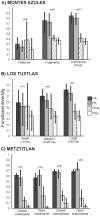Negative impacts of human land use on dung beetle functional diversity
- PMID: 21448292
- PMCID: PMC3063245
- DOI: 10.1371/journal.pone.0017976
Negative impacts of human land use on dung beetle functional diversity
Abstract
The loss of biodiversity caused by human activity is assumed to alter ecosystem functioning. However our understanding of the magnitude of the effect of these changes on functional diversity and their impact on the dynamics of ecological processes is still limited. We analyzed the functional diversity of copro-necrophagous beetles under different conditions of land use in three Mexican biosphere reserves. In Montes Azules pastures, forest fragments and continuous rainforest were analyzed, in Los Tuxtlas rainforest fragments of different sizes were analyzed and in Barranca de Metztitlán two types of xerophile scrub with different degrees of disturbance from grazing were analyzed. We assigned dung beetle species to functional groups based on food relocation, beetle size, daily activity period and food preferences, and as measures of functional diversity we used estimates based on multivariate methods. In Montes Azules functional richness was lower in the pastures than in continuous rainforest and rainforest fragments, but fragments and continuous forest include functionally redundant species. In small rainforest fragments (<5 ha) in Los Tuxtlas, dung beetle functional richness was lower than in large rainforest fragments (>20 ha). Functional evenness and functional dispersion did not vary among habitat types or fragment size in these reserves. In contrast, in Metztitlán, functional richness and functional dispersion were different among the vegetation types, but differences were not related to the degree of disturbance by grazing. More redundant species were found in submontane than in crassicaule scrub. For the first time, a decrease in the functional diversity in communities of copro-necrophagous beetles resulting from changes in land use is documented, the potential implications for ecosystem functioning are discussed and a series of variables that could improve the evaluation of functional diversity for this biological group is proposed.
Conflict of interest statement
Figures




References
-
- Chapin FS, Zavaleta ES, Eviner VT, Naylor LR, Vitousek PM, et al. Consequences of changing biodiversity. Nature. 2000;405:234–242. - PubMed
-
- Purvis A, Héctor A. Getting the measure of biodiversity. Nature. 2000;405:212–219. - PubMed
-
- Tilman D. Functional diversity. In: Levin SA, editor. Encyclopedia of biodiversity. San Diego: Academic Press; 2001. pp. 109–120.
-
- Díaz S, Cabido M. Vive la différence: plant functional diversity matters to ecosystem processes. Trends in Ecology and Evolution. 2001;16:646–655.
-
- Perrings C, Naeem S, Ahrestani F, Bunker DE, Burkill P, et al. Ecosystem services for 2020. Science. 2010;330:323–324. - PubMed
Publication types
MeSH terms
LinkOut - more resources
Full Text Sources
Medical

